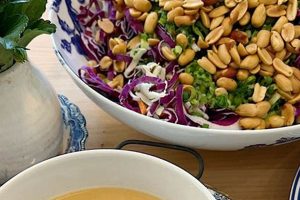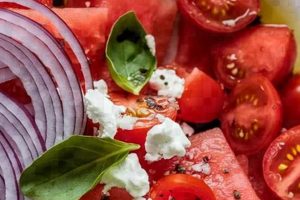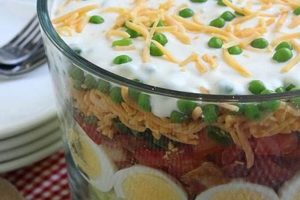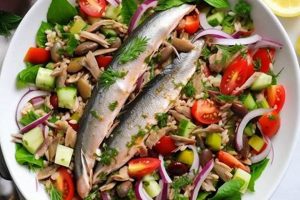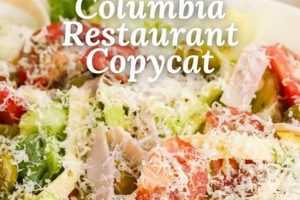This dish combines cooked macaroni and cheese, typically the classic cheddar-based variety, with additional ingredients to create a chilled salad. Common additions include vegetables like celery, bell peppers, and onions, as well as proteins such as ham, tuna, or bacon. A mayonnaise-based dressing often binds the ingredients together, sometimes incorporating mustard, vinegar, or other seasonings.
The appeal lies in its adaptability and convenience. It can be a refreshing side dish for barbecues or picnics, a potluck staple, or a quick and easy weeknight meal. Its versatility stems from the ability to customize ingredients and dressings to suit individual preferences. Historically, cold pasta salads gained popularity as refrigeration became more common, offering a make-ahead option for gatherings and busy households.
Further exploration will cover variations on this dish, from classic preparations to more innovative combinations, offering detailed guidance on ingredient selection, preparation techniques, and optimal serving suggestions.
Tips for Creating a Superior Macaroni and Cheese Salad
Elevating this classic dish requires attention to detail and a few key techniques. The following tips offer guidance on achieving optimal flavor and texture.
Tip 1: Pasta Perfection: Cook pasta al dente. Slightly firm pasta holds its shape better in the salad and prevents a mushy texture.
Tip 2: Cheese Selection: Sharp cheddar provides a robust flavor that stands up well to other ingredients. Experimenting with different cheeses, such as Gruyre or fontina, can add depth.
Tip 3: Flavorful Dressing: A balanced dressing is crucial. Mayonnaise provides creaminess, while mustard adds tang. A touch of vinegar or lemon juice brightens the overall flavor profile.
Tip 4: Vegetable Variety: Crisp vegetables like celery, red onion, and bell peppers offer textural contrast and freshness. Blanching certain vegetables, such as broccoli or cauliflower, can enhance their flavor and maintain their vibrant color.
Tip 5: Protein Power: Incorporating protein adds substance. Cubed ham, crumbled bacon, or flaked tuna are popular choices. Consider grilled chicken or shrimp for a lighter option.
Tip 6: Seasoning Savvy: Freshly ground black pepper, paprika, or garlic powder can enhance the overall flavor. Taste and adjust seasonings before chilling.
Tip 7: Chilling Time: Allowing the salad to chill for at least two hours allows the flavors to meld. This also firms the pasta and enhances the refreshing quality of the dish.
By following these guidelines, one can create a macaroni and cheese salad that is both flavorful and visually appealing. Attention to these details ensures a dish that satisfies a variety of palates.
These tips provide a foundation for crafting exceptional macaroni and cheese salad. The following section will explore variations and offer specific recipe examples for further inspiration.
1. Pasta Shape
Pasta shape contributes significantly to the overall success of a macaroni and cheese salad. The chosen shape influences not only the aesthetic appeal but also the texture and how well the pasta holds the dressing and incorporates other ingredients. Selecting the appropriate shape enhances the eating experience.
- Small and Tubular:
Shapes like elbows, ditalini, and small shells are classic choices. Their compact size and hollow centers readily absorb the dressing, ensuring even flavor distribution. These shapes also mix well with other ingredients, creating a cohesive salad.
- Rotini and Fusilli:
These spiral-shaped pastas offer textural intrigue and effectively capture bits of dressing and other ingredients within their curves. Their larger size provides a more substantial bite.
- Larger Cuts:
While less traditional, larger pasta shapes like penne, rottelle, or even farfalle (bowties) can be used. These require careful consideration of dressing consistency and ingredient size to ensure proper integration. They can contribute a more substantial, heartier feel to the salad.
- Novelty Shapes:
While less common, novelty pasta shapes can add a whimsical touch, especially for themed occasions. However, functionality should be considered. Overly intricate shapes may not hold dressing effectively or integrate well with other ingredients.
Ultimately, the ideal pasta shape depends on personal preference and the overall composition of the salad. While smaller shapes offer classic appeal and functionality, experimenting with different shapes can introduce variety and textural complexity to the dish. Careful consideration of pasta shape ensures a well-balanced and enjoyable macaroni and cheese salad.
2. Cheese Choice
Cheese selection significantly influences the flavor profile and overall success of macaroni and cheese salad. Careful consideration of cheese type, sharpness, and melting properties ensures a balanced and enjoyable dish. The following facets explore the impact of various cheese choices.
- Cheddar:
Cheddar, particularly sharp or extra sharp varieties, is a traditional and popular choice. Its pronounced flavor holds up well against other ingredients, providing a familiar and comforting base. Mild cheddar offers a gentler flavor, suitable for those who prefer a less intense cheese presence.
- Monterey Jack/Colby Blends:
These blends offer a creamy texture and milder flavor than cheddar, creating a smooth and rich base for the salad. Their melting properties contribute to a cohesive texture when combined with the dressing and other ingredients.
- Specialty Cheeses:
Introducing specialty cheeses like Gruyre, fontina, or Gouda can add depth and complexity. Gruyre offers nutty and slightly sweet notes, while fontina contributes a buttery and earthy flavor. Smoked Gouda introduces a smoky dimension. These cheeses can be incorporated alongside cheddar or used as the primary cheese component for a more nuanced flavor profile.
- Processed Cheese:
While some recipes utilize processed cheese for its consistent melting properties and smooth texture, its flavor profile can be less complex than that of natural cheeses. Considerations of flavor intensity and overall quality should guide the decision to incorporate processed cheese.
The interplay between cheese choice and other ingredients, such as the dressing and added vegetables, requires careful balancing. A sharp cheddar may pair well with a tangy vinaigrette, while a milder Colby might complement a creamy mayonnaise-based dressing. The selected cheese should harmonize with the other components, contributing to a cohesive and flavorful final product. Ultimately, the optimal cheese choice depends on individual preference and the desired flavor profile of the macaroni and cheese salad.
3. Dressing Consistency
Dressing consistency plays a crucial role in the overall quality and enjoyment of macaroni and cheese salad. The dressing serves not only as a flavor vehicle but also as a binding agent, bringing together the pasta, cheese, and other ingredients. Its consistency influences how well the salad holds its shape, how evenly the flavors distribute, and the overall textural experience.
- Classic Creamy:
A traditional mayonnaise-based dressing provides a rich and creamy texture that coats the pasta and other ingredients effectively. This consistency offers familiarity and comfort, clinging well to the pasta and creating a cohesive salad. Variations can include additions like mustard, vinegar, or sweet pickle relish for enhanced flavor complexity.
- Light and Tangy:
Vinaigrettes offer a lighter, more refreshing counterpoint to the richness of the cheese and pasta. A vinaigrette-based dressing, often incorporating olive oil, vinegar, and herbs, provides a tangy contrast and prevents the salad from feeling overly heavy. This consistency is particularly suitable for warmer weather or lighter flavor profiles.
- Yogurt-Based Dressings:
Using yogurt as a base offers a lighter and tangier alternative to mayonnaise, while still providing a creamy texture. Greek yogurt, in particular, contributes a protein boost and a slightly tangy flavor that complements the cheese and vegetables. This option can create a healthier and more refreshing salad.
- Balance and Texture:
Regardless of the base, dressing consistency requires careful consideration. Too thin a dressing will result in a watery salad that lacks cohesion, while too thick a dressing can overpower the other ingredients and create a heavy, less palatable dish. Achieving the right balance ensures that the dressing complements the other components without dominating the overall flavor and texture.
The chosen dressing consistency should complement the other ingredients and the desired overall character of the salad. A creamy dressing works well with classic additions like celery and ham, while a vinaigrette might better suit a salad with lighter vegetables and a focus on freshness. Careful consideration of dressing consistency ensures a harmonious balance of flavors and textures, contributing to a satisfying and enjoyable macaroni and cheese salad experience.
4. Added Vegetables
Added vegetables play a crucial role in enhancing both the nutritional value and the sensory experience of macaroni and cheese salad. Their inclusion introduces textural contrast, vibrant color, and fresh flavors that complement the richness of the cheese and pasta. The strategic selection and preparation of vegetables elevate this dish from a simple comfort food to a well-rounded and satisfying meal.
Cruciferous vegetables like broccoli and cauliflower offer nutritional benefits and contribute a slightly crisp texture when blanched before adding to the salad. Peppers, particularly bell peppers in various colors, introduce sweetness and visual appeal. The sharp bite of red onion provides a pungent counterpoint to the creamy dressing. Celery adds a refreshing crunch and subtle vegetal notes. Tomatoes, while sometimes included, require careful consideration due to their higher water content, which can contribute to a watery salad if not properly prepared, such as using cherry tomatoes or removing seeds and excess pulp from larger varieties.
Blanching or lightly steaming vegetables like broccoli, cauliflower, or green beans helps retain their vibrant color and crisp-tender texture while mitigating the release of excess moisture into the salad. Chopping vegetables into uniform sizes ensures even distribution throughout the salad and facilitates easier serving and consumption. Marinating certain vegetables, such as red onions in vinegar, can mellow their sharpness and enhance their flavor profile. Understanding the characteristics of different vegetables and employing appropriate preparation techniques maximizes their contribution to the overall quality and enjoyment of the macaroni and cheese salad.
5. Protein Additions
Protein additions contribute significantly to the heartiness and nutritional value of macaroni and cheese salad, transforming it from a side dish to a more complete meal. Strategic protein selection complements the existing flavors and textures while adding depth and satiety. The following facets explore various protein options and their impact on the overall composition of the dish.
- Cured Meats:
Cured meats like ham, bacon, and salami introduce salty, savory notes and a satisfying chew. Diced ham offers a classic pairing, while crumbled bacon adds a smoky richness. Salami contributes a spicy kick and a firmer texture. The quantity of cured meats should be balanced to avoid overwhelming the other flavors.
- Seafood:
Seafood options such as flaked tuna, shrimp, or crab offer a lighter protein alternative. Tuna provides a readily available and affordable option, while cooked shrimp or crab offer a more delicate flavor and texture. Ensuring seafood is properly cooked and chilled before adding to the salad is crucial for food safety.
- Poultry:
Cooked chicken or turkey, diced or shredded, contribute a lean protein source and a neutral flavor that readily absorbs the dressing and other seasonings. Grilled or roasted poultry adds a subtle smoky char, while poached or boiled poultry offers a cleaner flavor profile.
- Vegetarian Options:
For vegetarian variations, chickpeas, black beans, or edamame offer plant-based protein and textural diversity. Roasted chickpeas provide a satisfying crunch, while black beans contribute a mild earthiness. Edamame adds a fresh, slightly sweet flavor and vibrant green color.
The chosen protein should complement the other ingredients and the desired overall character of the salad. Consideration of flavor profiles, textures, and nutritional value ensures a well-balanced and satisfying dish. The addition of protein elevates macaroni and cheese salad from a simple side to a versatile and substantial meal option.
6. Seasoning Balance
Seasoning balance is paramount in a successful macaroni and cheese salad recipe. The inherent richness of the cheese and pasta necessitates careful consideration of complementary and contrasting flavors. A harmonious blend of seasonings elevates the dish beyond basic comfort food, adding depth and complexity. Over-seasoning can overwhelm the palate, while under-seasoning results in a bland and uninspired dish. Achieving the correct balance is crucial for a flavorful and enjoyable experience.
Salt, a fundamental seasoning, enhances the flavors of the other ingredients and balances the richness of the cheese. However, the salt content of ingredients like cheese, cured meats, and certain dressings must be considered to avoid over-salting. Black pepper adds a subtle heat and complexity. Garlic powder or granulated onion provides savory depth. Paprika contributes a smoky sweetness and vibrant color. Dry mustard enhances the tanginess of the dressing. Fresh herbs, such as chives or dill, offer a bright, herbaceous counterpoint. The interplay of these seasonings creates a nuanced flavor profile that complements the core ingredients. For example, a salad with sharp cheddar and ham benefits from the subtle heat of black pepper and the savory notes of garlic powder, while a salad with milder cheese and vegetables might be enhanced by the brightness of fresh dill and a touch of paprika.
Achieving seasoning balance requires tasting and adjusting throughout the preparation process. Initial seasoning of the pasta cooking water ensures foundational flavor. Incorporating seasonings into the dressing distributes them evenly throughout the salad. A final tasting before chilling allows for adjustments and ensures the desired flavor profile. This iterative process, combined with an understanding of flavor interactions, allows for precise seasoning and elevates the macaroni and cheese salad from simple to exceptional. Careful attention to seasoning balance results in a dish that is both flavorful and harmonious, showcasing the interplay of ingredients and seasonings.
7. Chilling Duration
Chilling duration significantly impacts the final quality of macaroni and cheese salad. This crucial step allows flavors to meld and textures to develop fully. The emulsification of the dressing stabilizes, and the pasta absorbs the flavors of the dressing and other ingredients more thoroughly. Chilling also firms the pasta, enhancing the textural contrast between the creamy dressing and the slightly firm noodles. A minimum chilling time of two hours is generally recommended, although longer durations, up to 24 hours, can further enhance flavor development, particularly when complex cheeses or seasonings are incorporated. For instance, a salad with a simple vinaigrette benefits from a shorter chilling time to maintain the brightness of the vegetables, while a salad with a richer, more complex dressing and ingredients like bacon or smoked Gouda may benefit from an overnight chill to allow the flavors to deepen.
Insufficient chilling can result in a bland, less cohesive salad with a watery consistency. The flavors may not have had adequate time to meld, and the pasta may not have fully absorbed the dressing, leading to a less satisfying textural experience. Conversely, excessive chilling can negatively impact the texture of certain vegetables, making them overly soft or mushy. Finding the optimal chilling duration depends on the specific recipe and ingredients used. Practical considerations, such as available refrigeration space and preparation timelines, also factor into determining the appropriate chilling time. Testing small batches with varying chilling times can help determine the ideal duration for a specific recipe.
Optimal chilling duration is essential for a well-balanced and flavorful macaroni and cheese salad. This step allows for the harmonious integration of flavors and textures, resulting in a more enjoyable culinary experience. Understanding the impact of chilling time and adapting it to specific recipes ensures a consistently high-quality final product. Balancing flavor development, texture optimization, and practical considerations yields a macaroni and cheese salad that is both delicious and satisfying.
Frequently Asked Questions
This section addresses common inquiries regarding the preparation and enjoyment of macaroni and cheese salad.
Question 1: What is the best pasta shape to use?
Small, tubular shapes like elbows, ditalini, and small shells are ideal for holding dressing and mixing well with other ingredients. Larger shapes can be used, but require careful consideration of dressing consistency and ingredient size.
Question 2: Can different cheeses be used?
While cheddar is traditional, variations using Gruyre, fontina, or Monterey Jack offer unique flavor profiles. Cheese selection should complement other ingredients and the desired overall taste.
Question 3: How can a watery salad be avoided?
Cooking pasta al dente prevents excess starch release. Thoroughly draining the pasta and chilling the salad adequately allows the dressing to emulsify and bind the ingredients effectively. Limiting high-water-content vegetables also helps prevent excess moisture.
Question 4: What are suitable protein additions?
Traditional choices include ham, bacon, tuna, or shrimp. For vegetarian options, chickpeas, black beans, or edamame offer plant-based protein.
Question 5: How long should the salad be chilled?
A minimum of two hours allows flavors to meld. Longer chilling, up to 24 hours, can deepen flavor complexity, but may affect the texture of some vegetables.
Question 6: Can the recipe be adapted for dietary restrictions?
Gluten-free pasta can be substituted for traditional pasta. Dairy-free cheese alternatives and vegan mayonnaise can create a vegan version. Adjustments to seasonings and other ingredients may be necessary to achieve optimal flavor balance.
Addressing these common questions provides a comprehensive understanding of the key elements contributing to a successful macaroni and cheese salad. Careful consideration of these aspects ensures a consistently delicious and satisfying dish.
The following section provides a collection of curated recipes, offering further inspiration and practical guidance for creating a variety of macaroni and cheese salads.
Mac and Cheese Salad Recipe
Exploration of this dish has revealed its versatility stemming from adaptable ingredients and methods. Key factors highlighted include pasta shape selection for optimal dressing adherence, cheese choices influencing flavor profiles, dressing consistency impacting overall texture, strategic vegetable additions for balanced nutrition and flavor, protein incorporation for enhanced heartiness, seasoning balance for nuanced taste, and chilling duration affecting flavor melding and texture. Understanding these elements allows for customization and consistently successful results.
This adaptable dish offers a canvas for culinary creativity. Potential exists for further exploration through innovative ingredient combinations, regional variations, and dietary adaptations. Continued experimentation promises to yield exciting new interpretations of this classic comfort food, ensuring its enduring appeal for generations to come.

